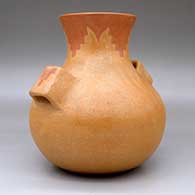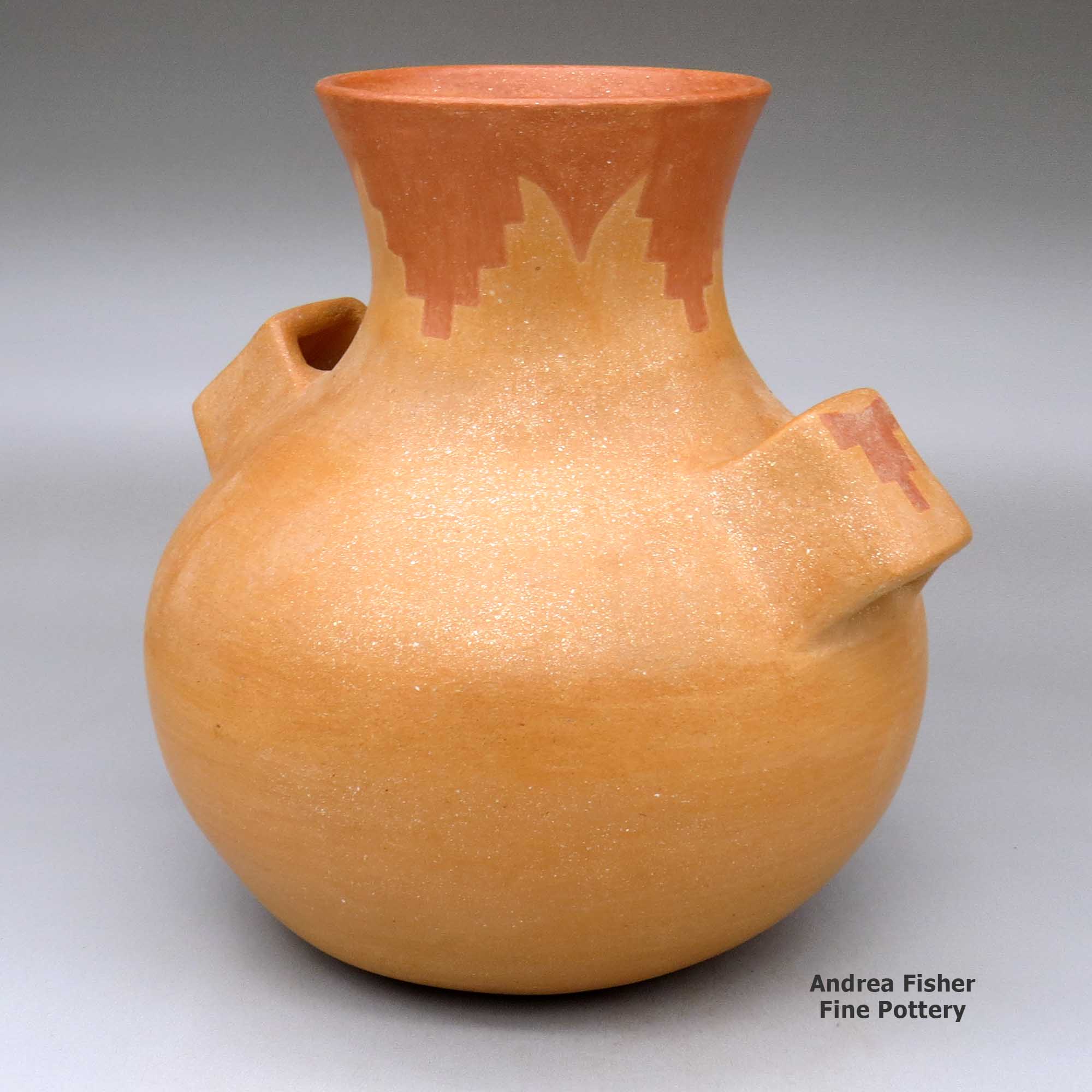
Click or tap to see a larger version
Lucy McKelvey, Dineh, A golden micaceous jar with handles and decorated with a geometric design around the rim and on the handles
Dineh
$ 1200
shnv4f313
A golden micaceous jar with handles and decorated with a geometric design around the rim and on the handles
9.75 in L by 10.5 in W by 10.5 in H
Condition: Very Good
Signature: Lucy McKelvey Navajo
Tell me more! Buy this piece!
(505) 986-1234 - www.andreafisherpottery.com - All Rights Reserved
Lucy Leuppe McKelvey
Dineh
Lucy Leuppe McKelvey was born into the Navajo Nation at Fort Defiance, Arizona, in April, 1946. She was raised by her grandparents: her grandfather was a traditional Navajo medicine man and her grandmother a traditional weaver. She never put her hands in clay until she was in college.
Lucy says she is essentially a self-taught potter but she picked up a lot of hints from watching her Hopi-Tewa neighbors who made pottery.
After graduating from High School, Lucy served her LDS missionary period with her own people. Then she attended Brigham Young University, graduating with a degree in Elementary Education and Indian Studies. She taught kindergarten through Junior High on the Navajo Nation for a few years, participating also as an artist-in-residence at the schools where she taught.
Over the years, Lucy has worked to elevate Navajo pottery into a fine art, producing large, polychrome pottery decorated with designs inspired by shards of ancient pottery she found around her grandmother's home, and designs from her people's ceremonial sand paintings, baskets and rugs, after making those designs her own, of course.
Sandpaintings are sacred to the Dineh. Making one into a permanent image and then putting it in a fire is the height of sacrelige to her people. Yeibichai are believed to be far too powerful for that. A way to avoid the problem is to alter the image and leave any Yeibichai pictured a way out. Lucy has said, "My grandfather, who was a medicine man, told me that it was okay to paint these designs as long as I did not exactly reproduce a sandpainting figure. That is why, while I take some inspiration from a sandpainting, I always change it and add something different."
A common theme in McKelvey pottery is "The Whirling Rainbow Goddesses of the Windway Ceremony." Lucy's grandfather was the last surviving member of that clan and when he passed on, those chants, designs and dances passed to her.
Lucy gathers her clays, pigments and other natural materials around Low Mountain in northeastern Arizona. Lucy has also taught her daughters Cecilia, Celeste and Celinda how to make pottery and they each have become renowned potters in their own right.
Dineh
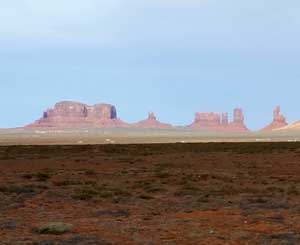
A view in Monument Valley
The Dineh refers to themselves as "Dineh" because the word means "the People" in their language. "Navajo" is a name that was given to them by the early Spanish. Historical and archaeological evidence points to the Dineh people entering the Southwest around 1400 CE. Their oral history still contains stories of that migration as the journey began in eastern Alaska and northwestern Canada centuries after their ancestors made the journey across the Bering Land Bridge from central Asia about 10,000 years ago. They were primarily hunter-gatherers until they came into contact with the Pueblo peoples and learned the basics of survival in this drier climate. Dineh oral history points to a long relationship between the Dineh and the Puebloans as they learned from and traded with each other.
When the Spanish first arrived, the Dineh occupied much of the area between the San Francisco Peaks (in Arizona), Hesperus Mountain and Blanca Peak (in Colorado) and Mount Taylor (in New Mexico). Spanish records indicate they traded bison meat, hides and stone to the Puebloans in exchange for maize and woven cotton goods. It was the Spanish who brought sheep to the New World and the Dineh took to sheep-herding quickly with sheep becoming a form of currency and sign of wealth.
When the Americans arrived in 1846, things began to change. The first fifteen years were marked by broken treaties and increasing raids and animosities on both sides. Finally, Brigadier General James H. Carleton ordered Colonel Kit Carson to round up the Dineh and transport them to Bosque Redondo in eastern New Mexico for internment. Carson succeeded only by engaging in a scorched earth campaign in which his troops swept through Dineh country killing anyone carrying a weapon and destroying any crops, livestock and dwellings they found. Facing starvation and death, the last band of Dineh surrendered at Canyon de Chelly.
Carson's campaign then led straight into "the Long Walk" to Bosque Redondo, a 300-mile trek during which at least 10% of the people died along the way. At Bosque Redondo they discovered the government had not allocated an adequate supply of water, livestock, provisions or firewood to support the 4,000-5,000 people interned there. The Army also did little to protect them from raids by other tribes or by Anglo citizens. The failure was such that the Federal government and the Dineh negotiated a treaty that allowed the people to return to a reservation that was only a shadow of their former territory little more than a couple years after they had left. However, succeeding years have seen additions to the reservation until today it is the largest Native American Reservation in the 48 contiguous states.
Large deposits of uranium were discovered on the Navajo Nation after World War II but the mining that followed ignored basic environmental protection for the workers, waterways and land. The Dineh have made claims of high rates of cancer and lung disease from the environmental contamination but the Federal government has yet to offer comprehensive compensation.
As a semi-nomadic tribe, the Dineh never made much pottery, preferring to use baskets for most storage purposes. They did produce a small amount of pottery for ceremonial uses. Once they were settled on a reservation, pottery began to make more sense. From a beginning making simple wares for colonial estates they transformed their pottery into art. After 1950 Cow Springs brownware began to appear on the market. A trader named Bill Beaver was in Shonto back then, encouraging local potters to "make something different" and the market in the outside world responded positively to those different creations.
Rose Williams is considered the matriarch of modern Dineh pottery. She learned from Grace Barlow (her aunt) and passed her knowledge and experience on to her daughters and many others. Today, most Dineh pottery is heavy, thick-walled and coated with pine pitch (a sealer they also use on many of their baskets). Most Dineh pottery has little in the way of decoration but many pieces have a biyo' (a traditional decorative fillet) around the rim. Unlike Puebloan potters, Dineh potters do not grind up old pot sherds and use them for temper in creating new pottery. Their religion says those pot sherds are infused with the spirits of their ancestors and that forbids the reuse of the material. Similarly, Dineh religion limits Dineh potters to using primarily Dineh carpet designs in the decoration of their pots.
Dineh potters have also created a panoply of folk art, including unfired clay creations called "mud toys." Other Dineh potters, like Christine McHorse, have graduated into the mainstream of American Ceramic Art and easily compete among the finest ceramic artists on Earth.

Navajo Nation at Wikipedia
The Dineh people at Wikipedia
Navajo Nation Government official website
Micaceous Clay Pottery

Angie Yazzie
Taos

Christine McHorse
Navajo
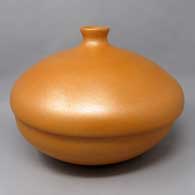
Clarence Cruz
San Juan/Ohkay Owingeh
Micaceous clay pots are the only truly functional Pueblo pottery still being made. Some special micaceous pots can be used directly on the stove or in the oven for cooking. Some are also excellent for food storage. Some people say the best beans and chili they ever tasted were cooked in a micaceous bean pot. Whether you use them for cooking or storage or as additions to your collection of fine art, micaceous clay pots are a beautiful result of centuries of Pueblo pottery making.
Between Taos and Picuris Pueblos is US Hill. Somewhere on US Hill is a mica mine that has been in use for centuries. Excavations of ancient ruins and historic homesteads across the Southwest have found utensils and cooking pots that were made of this clay hundreds of years ago.
Not long ago, though, the making of micaceous pottery was a dying art. There were a couple potters at Taos and at Picuris still making utilitarian pieces but that was it. Then Lonnie Vigil felt the call, returned to Nambe Pueblo from Washington DC and learned to make the pottery he became famous for. His success brought others into the micaceous art marketplace.
Micaceous pots have a beautiful shimmer that comes from the high mica content in the clay. Mica is a composite mineral of aluminum and/or magnesium and various silicates. The Pueblos were using large sheets of translucent mica to make windows prior to the Spaniards arriving. It was the Spanish who brought a technique for making glass. There are eight mica mining areas in northern New Mexico with 54 mines spread among them. Most micaceous clay used in the making of modern Pueblo pottery comes from several different mines near Taos Pueblo.
As we understand it, potters Robert Vigil and Clarence Cruz have said there are two basic kinds of micaceous clay that most potters use. The first kind is extremely micaceous with mica in thick sheets. While the clay and the mica it contains can be broken down to make pottery, that same clay has to be used to form the entire final product. It can be coiled and scraped but that final product will always be thicker, heavier and rougher on the surface. This is the preferred micaceous clay for making utilitarian pottery and utensils. It is essentially waterproof and conducts heat evenly.
The second kind is the preferred micaceous clay for most non-functional fine art pieces. It has less of a mica content with smaller embedded pieces of mica. It is more easily broken down by the potters and more easily made into a slip to cover a base made of other clay. Even as a slip, the mica serves to bond and strengthen everything it touches. The finished product can be thinner and have a smoother surface. As a slip, it can also be used to paint over other colors of clay for added effect. However, these micaceous pots may be a bit more water resistant than other Pueblo pottery but they are not utilitarian and will not survive utilitarian use.
While all micaceous clay from the area of Taos turns golden when fired, it can also be turned black by firing in an oxygen reduction atmosphere. Black fire clouds are also a common element on golden micaceous pottery.
Mica is a relatively common component of clay, it's just not as visible in most. Potters at Hopi, Zuni and Acoma have produced mica-flecked pottery in other colors using finely powdered mica flakes. Some potters at San Ildefonso, Santa Clara, Jemez and San Juan use micaceous slips to add sparkle to their pieces.
Potters from the Jicarilla Apache Nation collect their micaceous clay closer to home in the Jemez Mountains. The makeup of that clay is different and it fires to a less golden/orange color than does Taos clay. Some clay from the Picuris area fires less golden/orange, too. Christine McHorse, a Navajo potter who married into Taos Pueblo, uses various micaceous clays on her pieces depending on what the clay asks of her in the flow of her creating.
There is nothing in the makeup of a micaceous pot that would hinder a good sgraffito artist or light carver from doing her or his thing. There are some who have learned to successfully paint on a micaceous surface. The undecorated sparkly surface in concert with the beauty of simple shapes is a real testament to the artistry of the micaceous potter.

Lonnie Vigil
Nambe

Robert Vigil
Nambe
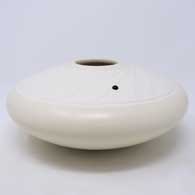
Preston Duwyenie
Hopi
Copyright © 1998-2025 by

